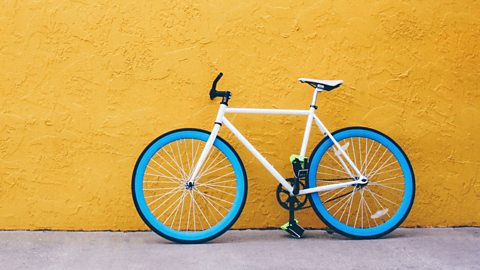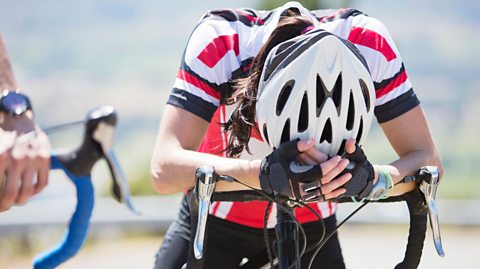Summer can be a great opportunity to escape the hustle and bustle of daily life and enjoy a good bike ride.
And if the weather doesn't allow it, you can always live vicariously through the Tour de France.
As well as fun, cheap and clean, bikes are an excellent way to witness science in action. Academics have been fascinated by the humble bike for a long time, but there's one question that still causes some disagreement: how does a bike stay upright? Dr Hugh Hunt from the University of Cambridge has looked at the physics of everyday objects, from spinning tops to boomerangs. He gets around town every day by bike and wants to give us the lowdown on this scientific classic.

Back to the basics
Early bikes, like the penny farthing, had different sized wheels, hard tires, no gearing and no brakes - balancing on them was hard. These days, we're used to to bikes with a comfortable ride, thanks to pneumatic tyres and springs under the seat. Each component of your bike has an important role in the science of cycling and balancing.
Take the gears, for example. They are pretty important to ride on different terrains, to go up and down hills, or if you want to accelerate quickly - and speed is your friend when it comes to balance.
Wheels are the other unsung heroes of bike balance. Think about it: those spokes are so thin that, if you put all your weight on them, they’d buckle. But when you sit on the bike, the axle pulls down on the rim and acts like an arch. In a way, it's similar to when you're sitting on a swing and you're hanging from the frame on ropes. The spokes at the top of the bike wheel do the same sort of work and you are, in effect, hanging off the rim of the wheel.
The big question
Scientists have been interested in how the parts of a bike interact with each other and with external forces pretty much since bikes were invented. Nowadays we have a good understanding of the forces of cycling, but how a bike stays upright still divides opinion.
Ask the question and someone will mention what's known as the gyroscopic effect, which occurs because a spinning wheel wants to stay spinning about its axis - much like a spinning top, or even planet Earth, stay aligned to their spin axes.
We know that the gyroscopic effect helps a wheel stay upright - just roll a coin on a table and you see that it doesn't fall over. But it has to be going fast enough. The gyroscopic effect produces a restoring force that doubles with a doubling of speed.
So an everyday cyclist won't notice it, but a racing cyclist going ten times faster will feel it. Likewise, bigger and heavier wheels have a bigger gyroscopic kick. If you've ever used a hand-held blender or a high-power hair drier, that's what a gyroscopic kick feels like.

If a bike did stay upright because of the gyroscopic effect, anyone learning to ride could just get on a bike and go. But you have to learn how to ride, just as you learn how to walk. Riding a bike is a skill, and I believe it’s all about wobbling. The secret of bike balance is all in what scientists call the bike-rider system.
When riding, you're always steering left and right in tiny movements. If you are falling to the right, then you subconsciously steer a bit to the right so that your wheels move underneath you. So you steer into the fall, so the wheels don't slip out from under you, much like when you're walking or running you would move your foot to the right if you were losing balance in that direction. Then, without thinking, you steer back again to stay on the path.
This will be obvious if you're a beginner, as you'll wobble around quite a lot, but it may be almost imperceptible in an experienced cyclist. Nevertheless, these little wobbles are essential and explain why riding on a dead straight line is so hard: because you can't make those essential little side-to-side corrections.
These corrections are also at the heart of what is known as 'track standing' in cycling jargon. If you've ever noticed someone balancing themselves on a bike at a traffic light, standing on their pedals and without putting a foot down, they're effectively rocking the bike backward and forward so it stands still.
Riderless bikes
Some scientists, including myself, have altered bikes to cancel the gyroscopic effect out. Years ago, I built a bike with a backward spinning wheel, and I found that the bike was just as easy to ride even if the backward wheel was going very fast.
OK, so what if there's no cyclist on the bike? Imagine 'launching' a bike by giving it a good push. As long as it's rolling fast enough, it's likely that a bike can keep going for a while without tipping.
Again, the gyroscopic effect of the front wheel has been traditionally used to explain this phenomenon. However, in 2011 an international team of scientists also built an experimental bike without any gyroscopic effect that could still balance itself. How did it do it? Pretty much like a human rider - by steering itself. Professor Andy Ruina, who headed the research group, explained in an interview on his university's website: "The amazing thing about bicycles is that… somehow a bicycle, if it's moving fast enough and not too fast, will steer itself and balance."
So one thing's for sure: when you learned to ride a bike, it was all down to your skill and nothing to do with the gyroscopic effect.
This article was published in July 2019
The cycling jargon you need to know about
Why you need to worry about bonking if you leave the peloton - and others.

When does summer *really* start?
Is summer solstice the start or the middle of summer? We can't rely on the weather, so we asked the experts.

Six sports movies that got their facts wrong
Films about sport like Creed and Cool Runnings are very entertaining, but not always accurate.
